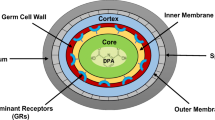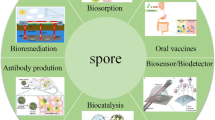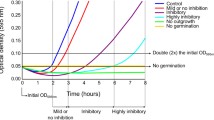Abstract
Several microorganisms like bacteria, fungi, yeast, algae, actinomycetes and protozoa are well known for their ability to form spores. Spores have inherently distinct life cycle as compared to vegetative cells making them able to resist various unfavourable environmental conditions like extreme temperature, radiations, desiccation, toxic chemicals, etc. Keeping in view their vast potential, the use of spores has led to several breakthrough researches in order to develop a large number of spore-based products in the fields of biosensing, biocontrol, biofertilizers, biocatalysis, biosorption, biopolymers, biological warfare, medicine, probiotics and surface display. Most of these products are now available commercially and thus indicate the indispensable potential of microbial spores. The current chapter gives information about the concept of microbial spores and its potential industrial applications in aforementioned fields. Furthermore, attention has also been paid to the current status, associated challenges and future perspectives for spore-based technologies.
Access this chapter
Tax calculation will be finalised at checkout
Purchases are for personal use only
Similar content being viewed by others
References
Arora S, Kumar N, Yadav A, Raghu HV (2016) Spore: potential of invaluable bacterial wrap. Int J Life Sci Sci Res 2:513–518
Balhara M, Kumar N, Thakur G et al (2013) A Novel enzyme substrate based bioassay for real tie detection of Listeria monocytogenes in milk. Indian Patent Reg No. 1357/DEL/2013
Burleigh S, Torrey JG (1990) Effectiveness of different Frankia cell types as inocula for actinorhizal plant Casuarina. Appl Environ Microbiol 56:2565–2567
Coleman WH, Zhang P, Li Y, Setlow P (2010) Mechanism of killing of spores of Bacillus cereus and Bacillus megaterium by wet heat. Lett Appl Microbiol 50:507–514
Cutting SM (2011) Bacillus probiotics. Food Microbiol 28:214–220
Cutting SM, Ricca E (2014) Bacterial spore-formers: friends and foes. FEMS Microbiol Lett 358:107–109
Das S, Kumar N, Raghu HV, Haldar L et al (2011) Microbial based assay for specific detection of β-lactam group of antibiotics in milk. J Food Sci Technol 51:1161–1166
Dehel T (2006) Charged bacterial spore uplift and outflow via electric fields. COSPAR-A-00001, F3.1-0017-06
FAO/WHO (2005) Probiotic in foods: health and nutritional properties and guidelines for evaluation. In: FAO food and nutrition. FAO/WHO, Rome, p 85
Farenhorst M, Hilhorst A, Thomas MB, Knols BGJ (2011) Development of fungal applications on netting substrates for malaria vector control. J Med Entomol 48:305–313
Fourest E, Roux J (1992) Heavy metal biosorption by fungal mycelial byproduct: mechanisms and influence of pH. Appl Microbiol Biotechnol 37:399–403
Gavimath CC, Mali BM, Hooli VR et al (2012) Potential application of bacteria to improve the strength of cement concrete. Int J Adv Biotechnol Res 3:541–544
Hawksworth DL, Wiltshire PEJ (2011) Forensic mycology: the use of fungi in criminal investigations. Forensic Sci Int 206:1–11
Hinc K, Ghandili S, Karbalaee G et al (2010) Efficient binding of nickel ions to recombinant Bacillus subtilis spores. Res Microbiol 161:757–764
Hong HA, le Duc H, Cutting SM (2005) The use of bacterial spore formers as probiotics. FEMS Microbiol Rev 29:813–835
Kanatiwela HMCK, Adikaram NKB (2009) A TLC-bioassay based method for detection of fungicide residues on harvested fresh produce. J Natl Sci Found Sri Lanka 37:257–262
Kardas I, Struszczyk MH, Kucharska M, van den Broek LAM, van Dam JEG, Ciechanska D (2012) Chitin and chitosan as functional biopolymers for industrial applications. In: Navard P (ed) The European polysaccharide network of excellence. Springer, Vienna, pp 329–373
Khetan SK (2001) Microbial pest control. Marcel Dekker, New York/Basel, p 300
Kratochvil D, Volesky B (1998a) Advances in the biosorption of heavy metals. Trends Biotechnol 16:291–300
Kratochvil D, Volesky B (1998b) Biosorption of Cu from ferruginous wastewater by algal biomass. Water Res 32:2760–2768
Kumar N, Sawant S, Malik RK, Patil GR (2006) Development of analytical process for detection of antibiotic residues in milk using bacterial spores as biosensor. Indian Patent Reg. No. 1479/DEL/2006
Kumar N, Khan A, Arora S, Patra F et al (2014) Enzyme-spore based assay(s) for detection of antibiotic residues in milk. IPR No: 2213/DEL/2014
Kumar N, Tehri N, Gopaul R et al (2015). Rapid spores-enzyme based miniaturised assay (s) for detection of pesticide residues. Indian Patent Reg. No. 3819/DEL/2015
Lalonde M, Calvert HE (1979) Production of Frankia hyphae and spores as an infective inoculant for Alnus species. In: Gordon JC, Wheeler CT, Perry DA (eds) Symbiotic nitrogen fixation in the management of temperate forest. USDA Forest Research Laboratory, Oregon State University, Corvallis, pp 95–110
le Duc H, Hong HA, Barbosa TM, Henriques AO, Cutting SM (2004) Characterization of Bacillus probiotics available for human use. Appl Environ Microbiol 70:2161–2171
Lee Y, Tebo BM (1994) Cobalt oxidation by the marine manganese (II) – oxidizing Bacillus sp. strain SG-1. Appl Environ Microbiol 60:2949–2957
Lee DW, Lim H, Chong HN, Shim WS (2009) Advances in chitosan material and its hybrid derivatives: a review. Open Biomater J 1:10–20
Lewis K, Whipps JM, Cooke RC (1989) Mechanisms of biological disease control with special reference to the case study of Pythium oligandrum as an antagonist. In: Whipps JM, Lumsden RD (eds) Biotechnology of fungi for improving plant growth. Cambridge University Press, Cambridge, pp 191–217
Mauriello EMF, Duc L, Isticato R et al (2004) Display of heterologous antigens on the Bacillus subtilis spore coat using CotC as a fusion partner. Vaccine 22:1177–1187
Meldrum FC (2003) Calcium carbonate in biomineralisation and biomimetic Chem. Int Mater Rev 48:187–224
Muradov N, Taha M, Miranda AF, Wrede D et al (2015) Fungal-assisted algal flocculation: application in wastewater treatment and biofuel production. Biotechnol Biofuels 8:24
Murata K (1993) Use of microbial spores as a biocatalyst. Crit Rev Biotechnol 13:173–193
Paidhungat M, Setlow P (2002) Spore germination and outgrowth. In: Sonenshein AL, Hoch JA, Losick R (eds) Bacillus subtilis and its closest relatives: from genes to cells. ASM Press, Washington, DC
Potot S, Serra CR, Henriques AO, Schyns G (2010) Display of recombinant proteins on Bacillus subtilis spores, using a coat-associated enzyme as the carrier. Appl Environ Microbiol 76:5926–5933
Reid G, Jass J, Sebulsky MT, McCormick JK (2003) Potential uses of probiotics in clinical practice. Clin Microbiol Rev 16:658–672
Rhee KJ, Sethupathi P, Driks A et al (2004) Role of commensal bacteria in development of gut associated lymphoid tissues and preimmune antibody repertoire. J Immunol 172:1118–1124
Setlow P (1983) Germination and outgrowth. In: Gould GW, Hurst A (eds) The bacterial spore, vol II. Academic, London, pp 211–254
Setlow P (2006) Spores of Bacillus subtilis: their resistance to radiation, heat and chemicals. J Appl Microbiol 101:514–525
Setlow P, Johnson EA (2007) Spores and their significance. In ed. Doyle, M.P. and Beuchat, L.R Food microbiology, fundamentals and frontiers, 3rd edn, . Washington, DC: ASM Press, p. 35–67
Shahidi F, Arachchi JKV, Jeon YJ (1999) Food applications of chitin and chitosans. Trends Food Sci Technol 10:37–51
Shigematsu T, Matsutani K, Fukuda Y et al (1993) Enzymes and germination of spores of a yeast Saccharomyces cerevisiae. J Ferment Bioeng 75:187
Suva MA, Sureja VP, Kheni DB (2016) Novel insight on probiotic Bacillus subtilis: mechanism of action and clinical applications. J Curr Res Sci Med 2:65–72
Tehri N, Kumar N, Raghu HV et al (2017) Role of stereospecific nature of germinants in Bacillus megaterium spores germination. 3 Biotech 7:259
Whalon ME, McGaughey WH (1998) Bacillus thuringiensis: use and resistance management. In: Insecticides with novel modes of action, mechanism and application. Springer, New York
Xi Chen, Mahadevan L, Driks A, Sahin O (2014) Bacillus spores as building blocks for stimuli-responsive materials and nanogenerators. Nat Nanotechnol 9:137–141
Yung PTD (2008) Detection of aerobic bacterial endospores: from air sampling, sterilization validation to astrobiology. Doctoral thesis. Submitted to California Institute of Technology Pasadena, California
Zhang H, Tachikawa H, Gao X-D, Nakanishi H (2014) Applied usage of yeast spores as chitosan beads. Appl Environ Microbiol 80:5098–5105
Author information
Authors and Affiliations
Corresponding author
Editor information
Editors and Affiliations
Rights and permissions
Copyright information
© 2018 Springer Nature Singapore Pte Ltd.
About this chapter
Cite this chapter
Tehri, N., Kumar, N., Raghu, H.V., Shukla, R., Vashishth, A. (2018). Microbial Spores: Concepts and Industrial Applications. In: Singh, J., Sharma, D., Kumar, G., Sharma, N. (eds) Microbial Bioprospecting for Sustainable Development. Springer, Singapore. https://doi.org/10.1007/978-981-13-0053-0_15
Download citation
DOI: https://doi.org/10.1007/978-981-13-0053-0_15
Published:
Publisher Name: Springer, Singapore
Print ISBN: 978-981-13-0052-3
Online ISBN: 978-981-13-0053-0
eBook Packages: Biomedical and Life SciencesBiomedical and Life Sciences (R0)




